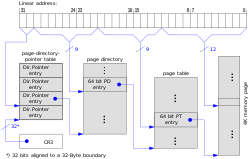Physical Address Extension
In computing, Physical Address Extension (PAE) is a processor feature to enable 32-bit IA-32 central processing units (CPUs) to access physical address space larger than 4 gigabytes by extending the paging schema .[1] It allows up to 64 gigabytes of system memory to be addressed by a 32-bit processor.[2]
PAE was first introduced with the Intel 32-bit processor Pentium Pro.[2] Since then it has been a feature on all Intel processors except some Pentium M mobile processors.[2] Athlon or K7 is the first processor from AMD supported PAE. Now all AMD processors support PAE.[2] In addition to processor support, PAE requires the operating system (OS) to support it.[3] Windows 2000 was the first OS to support PAE.[3]
Desktop Processors
| Processors | Physical Addressing Bit Width |
|---|---|
| Intel Pentium Pro/Pentium II/Pentium III/Pentium II Celeron/Celeron | 36 bits |
| Intel Pentium 4/Pentium 4 Celeron/Pentium D/Celeron D | 36 bits |
| Intel Core 2/Pentium Dual-Core/Celeron | 36 bits |
| Intel Core i3/i5/i7/Celeron/Pentium | 36/39 bits |
| AMD Athlon 64/Athlon X2/Sempron/Sempron X2 | 40 bits |
| AMD Athlon/Athlon II/Sempron/Sempron X2 | 48 bits |
| AMD C-50 | 36 bits |
| AMD APU A4/A5/A6/A8/Athlon/Sempron | 48 bits |
Physical Address Extension Media
References
- ↑ "Physical Address Extension". Windows Dev Center. Retrieved 31 December 2014.
- ↑ 2.0 2.1 2.2 2.3 Eric Hammersley, Professional VMware Server (Indianapolis, IN: Wrox/Wiley Pub., 2007), p. 13
- ↑ 3.0 3.1 "Microsoft Partners With Sequent for High-End Windows 2000." Computergram International. 1999. HighBeam Research. (December 31, 2014). http://www.highbeam.com/doc/1G1-54714335.html Archived 2016-04-21 at the Wayback Machine



